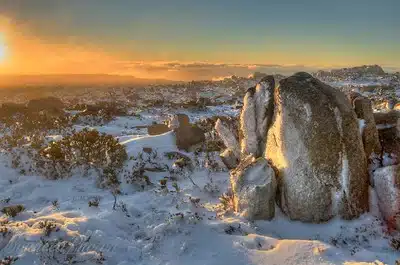Learn About the Best-Known and Snow-Covered Destinations In Australia
Learn About the Best-Known and Snow-Covered Destinations In Australia
Blog Article
Understanding the Importance of Snow in Australia for Agriculture and Tourist
While Australia is often linked with sun-kissed coastlines and dry wilderness, it also flaunts a wide range of snowy towering regions. As we investigate this shocking crossway, the prospective influence of changing climate patterns on Australia's snowfall and its succeeding results end up being a compelling emphasis.

The Unexpected Snowfall: Australia's Alpine Regions
When winter months capes the world, Australia's Alpine areas put on a white mantle of snow, a spectacle that appears almost paradoxical in this dominantly sun-baked land. Unlike the stereotyped photo of Australia as a land of beaches and deserts, these regions use a shocking and attractive comparison. The Australian Alps, extending across New South Wales, Victoria, and the Australian Funding Territory, obtain even more snowfall than Switzerland. This unexpected winter months wonderland supplies a special environment, offering a habitat for a number of native types and a snowy play area for wintertime sports lovers. The annual snowfall, although not as plentiful as in some nations, is a crucial aspect of Australia's environment diversity and plays a significant duty in the country's farming methods and tourism industry.
Winter season's Bounty: Snow's Contribution to Australia's Water Resources
Despite its rarity in the wider landscape of Australia, snow in the Alpine areas plays a crucial role in the nation's water sources. Acting as an all-natural reservoir, the snowpack shops water throughout the chilly months, progressively releasing it into rivers and dams as it melts in warmer periods. This process ensures a stable supply of water, assisting in the stabilization of the nation's water cycle. This is particularly essential for Australia, a continent frequently afflicted by dry spells. The snowmelt feeds right into the Murray-Darling Basin, a lifeline for lots of communities in the southeastern parts of the nation. Without the bounty of winter months snow, Australia's water sources would be substantially strained, influencing both the atmosphere and the population.
White Covering, Environment-friendly Area: The Impact of Snow on Australian Farming
Although less visible, the impact of snow on Australian agriculture is significant. Snowfall in the high country acts as an all-natural form of watering, slowly melting and supplying a consistent water system to lower-lying farmland. This water-rich environment cultivates the growth of robust crops, contributing to the nation's farming efficiency. Furthermore, snowfall improves dirt wellness by presenting wetness and trapping nutrients, which are gradually released as the snow melts. This process enriches the dirt, promoting the development of healthier, a lot more durable crops. In addition, snow cover works as a protective blanket, protecting the ground versus extreme wintertime temperature levels that might or else damage crops. Hence, the role of snow in Australian agriculture is both essential and complex.

Money: Snow Tourism and Its Economic Value in Australia
While the value of snow to Australian agriculture is commonly taken too lightly, its payment to the nation's tourism field is undeniably considerable. The snow-laden heights of Australia's alpine areas draw in a Read More Here flurry of why not try this out visitors every winter months, contributing millions to the national economy. Hence, the economic value of snow tourist in Australia prolongs far past the inclines.
Future Projection: Climate Modification and Its Prospective Results on Australia's Snowfall
As the globe comes to grips with the truth of climate change, so too needs to Australia contemplate its prospective effects on the nation's snowfall. Current scientific versions predict a decrease in Australian snowfall, with possibly severe effects on both agriculture and tourism. In some locations, the snow season could be reduced by approximately 80 days by 2050. Such adjustments endanger the practicality of Australia's ski sector, which adds considerably to the local economic climate. Less snowfall can additionally influence the nation's agricultural industry, as snowmelt plays a critical duty in watering crops. The prospective results of these adjustments underscore the seriousness of climate modification reduction initiatives, both in Australia and around the world.
Final Thought
In conclusion, snow is a critical aspect of Australia's farming and tourist markets. It not just nourishes the country's agricultural landscape but also gas its wintertime tourism industry. The looming threat of environment change elevates problems regarding the future of Australia's snowfall patterns, potentially interfering with these considerable economic markets. Consequently, understanding and addressing these obstacles is important for the sustainability of Australia's economy and ecological community.

When winter months cloaks the globe, Australia's Alpine areas her latest blog wear a white mantle of snow, a spectacle that appears virtually paradoxical in this dominantly sun-baked land.Despite its rarity in the more comprehensive landscape of Australia, snow in the Towering areas plays an important duty in the nation's water resources. Without the bounty of wintertime snow, Australia's water sources would certainly be considerably stressed, influencing both the atmosphere and the populace.
Hence, the economic importance of snow tourism in Australia prolongs much past the inclines.
In final thought, snow is a critical aspect of Australia's agricultural and tourist markets. Does It Snow In Australia.
Report this page